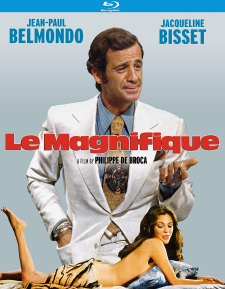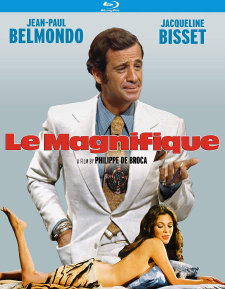Le Magnifique (Blu-ray Review)

Director
Phillipe de BrocaRelease Date(s)
1973 (June 8, 2021)Studio(s)
Cine III (Kino Lorber Studio Classics)- Film/Program Grade: A-
- Video Grade: B
- Audio Grade: B-
- Extras Grade: B
Review
Le Magnifique is a hilarious and multilayered 1973 comedy from director Philippe de Broca which manages to parody not just spy films of the era, but also the parodies of spy films, such as the Matt Helm series. Not content with merely parodying parodies, Le Magnifique even parodies itself. Nothing is off the table, from broad slapstick to over-the-top violence to outright surrealism. Yet it’s all done with a purpose, and the reasons why become clear as the film unfolds.
Sometimes known as The Man from Acapulco in the US, Le Magnifique is the saga of superspy Bob Saint-Clar (Jean-Paul Belmondo) as he joins the beautiful but deadly Tatiana (Jacqueline Bisset) to spar with his Algerian nemesis Karpof (Vittorio Caprioli)… at least until the needle comes out of the groove partway into the film with a surrealistic flourish that would have made Luis Bunuel proud as it changes the nature of the story drastically. The fascinating thing about Le Magnifique is that it’s not just escapist entertainment, but also entertainment about escapism.
Francis Veber wrote the original screenplay, but it was rewritten over his objections by de Broca, Caprioli, and Jean-Paul Rappeneau. He subsequently asked for his name to be removed from the film (the credits actually omit all of the writers). Regardless of whether or not the final film matches Veber's intentions, it’s hard to argue with the results when they are this memorable.
Belmondo was the perfect choice to star as it allowed him to play with his own image in sometimes unexpected ways, deftly handling everything that the script throws at him. He not only plays multiple roles, but multiple versions of the same role as well. The rest of the cast also gets into the spirit of things, with even Bisset clearly enjoying her participation in all of the shenanigans.
Le Magnifique never falls in love with its own cleverness, but instead transcends all of the gimmicks and gags by examining the way that fiction is used to escape the realities of life while providing wish fulfillment at the same time. Ultimately, the film makes the humanistic choice to embrace life and accept the real world with all of its anxieties and challenges by throwing fantasy out of the window—literally, in this case. It’s a surprising yet very satisfying message for a film that spends so much time showing how much fun that fantasy worlds can be.
Cinematographer Rene Mathelin shot Le Magnifique on 35 mm film using Panavision cameras and lenses, and it was framed at 1.66:1 for its European theatrical release (it may have been cropped to 1.85:1 in the United States, but I couldn’t verify that). The transfer from Kino Lorber Studio Classics is properly framed at 1.66:1. The image is clean with smoothness in some of the textures which indicates that either DNR was applied or there are compression issues despite the relatively high bit rate. Fine detail is visible whenever everything is static, but as soon things are in motion, those same textures are occasionally smeared (the scene in the park starting at about the 01:13:30 mark is a prime example of how the detail of the sand and grass gets lost whenever the camera is moving). On the other hand, the color balance is good and it accurately represents the way that Mathelin’s cinematography supports the multilayered narrative, alternating between bright hues and drab earth tones. Contrast and black levels are both fine as well.
The audio defaults to English 2.0 mono DTS-HD Master Audio. A French 2.0 mono DTS-HD Master Audio 2.0 track with optional English subtitles is also available. The French version is preferable as the English dubbing is not very impressive. Bisset performed all of her dialogue in French meaning that her lip sync is actually mismatched in the English dub. The entire film was post-synced, so the dialogue doesn’t integrate that well anyway, which is typical of European films of the era. While everything sounds clear and overall fidelity is somewhat limited, Claude Bolling’s versatile score still stands out.
Extras on the disc include the following:
- Audio Commentary by Howard S. Berger, Steve Mitchell, and Nathaniel Thompson
- Trailer (SD – 2:26)
- Cartouche Trailer (SD – 3:32)
- Leon Morin, Priest Trailer (HD – 3:16)
- Le Doulos Trailer (HD – 2:25)
- Le Professionnel Trailer (SD – 2:12)
- The Outsider Trailer (HD – 2:43)
- The Mephisto Waltz Trailer (SD – 2:27)
- The Greek Tycoon Trailer (HD – 2:24)
- Scenes from the Class Struggle in Beverly Hills Trailer (HD – 2:05)
Film historians Berger, Mitchell, and Thompson are the best possible group to do a commentary for a film like Le Magnifique. They all share equal enthusiasm for the film, but each of them also brings his own unique perspective. Berger, for example, inevitably talks about his favorite subject of “dummy deaths” in cinema and how the substitutions in this film relate to its themes of identity. The group discusses their own experiences of seeing the film for the first time, its shocking level of exaggerated violence, how it pays homage to specific cultural touchpoints from its era, and how much it owes to Get Smart. They also cover how Le Magnifique fits into the filmographies of de Broca, Belmondo, and Bisset, as well as how there’s far more depth to the main character than meets the eye. Overall, it’s a very enjoyable track that will enhance your appreciation of the film.
The trailers are for films featuring either Jean-Paul Belmondo or Jacqueline Bisset. They’re all interesting as they show some of the breadth of the films done by both of those actors, but the real prize is the trailer for Scenes from the Class Struggle in Beverly Hills. Director Paul Bartel appears on screen to tell the audience that he’s worried about having to meet with the censors over the outrageous content in the film. It’s a great example of the lost art of creative trailers which didn’t simply show film clips. It’s also a reminder of what kind of a talent that Bartel was on both sides of the camera.
Le Magnifique may not be that familiar to those who are not already fans of de Broca, Belmondo, or French cinema in general, but it has many universal qualities which should appeal to film fans of any variety. Short of having the opportunity to catch the film in a theater with an appreciative audience, Kino’s new Blu-ray is the best way to experience it for old fans and new fans alike.
- Stephen Bjork
(You can follow Stephen on Facebook at this link)

